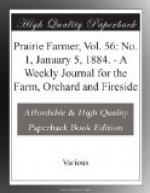The name given to this valuable grass in the State of Michigan is “Evergreen,” but this is only a local synonym. Its scientific name is Avena elatior; its common name, “Tall Meadow Oat-grass.” Fearing that he might be mistaken in its nomenclature, he sent a specimen to Professor Carruth, State Botanist. This is his reply:
“Mr. J.W. Robson—Dear Sir: Yours mailed on the 22d, I received last evening. I do not get my mail every day. The specimen of grass you sent agrees perfectly with the Avena elatior, of Wood, and the Arrenatherrum avenaceum, of Gray; but I have never seen this grass before. I agree with you in the scientific name, and also in the common name, ’Tall Meadow Oat-grass.’
Yours truly, J.H. Carruth.”
The ground should be plowed in the fall, and early in the spring, as soon as the soil is in good tilth; sow broadcast two bushels (or twenty-eight pounds) of seed to the acre; cover well with the harrow, both lengthways and across the piece of ground sown. Should the ground prove weedy, cut the weeds down with the mowing machine in June, and leave them upon the surface, and they will afford shade to the young plants.
This grass is extensively grown in Eastern Tennessee, and is very popular in that portion of the State. In some portions of Western Virginia it is largely grown for hay and for grass. It is known as tall meadow oat-grass in each of the States we have mentioned above.
* * * * *
The main building for the New Orleans Cotton Centennial Exposition next year will be 1,500 feet long and 900 feet wide, with 1,000,398 square feet of floor space, including Music Hall in the center, with a seating capacity of 12,000 persons. The design also provides for main offices, telegraph office, newspaper department, fire department, police, hospital, waiting-rooms, and life saving apparatus. The building will be the largest exposition building ever erected, except the one in London in 1862. The design adopted was the work of G.M. Jorgenson, of Meridian, Mississippi. There were ten competitors.
JOSEPH F. GLIDDEN.
The Barb-Wire Industry—Some Facts in its Early History not Generally Known—Its Growth.
Joseph Farwell Glidden, “the Father of the Barb-Wire Business” of this country, is now a hale and hearty man of seventy-one. He was born at Charleston, N.H. When about one year old the family came West, to Clarendon, Orleans county, New York, and engaged in farming. The young lad, besides mastering the usual branches taught in the common schools, gave some time to the higher mathematics and Latin, intending to take a college course, an idea that he finally abandoned. He taught in the district schools for a few terms. In 1842 he came to Illinois and purchased a quarter section of land a mile west of what is now the site of the pleasant and prosperous




